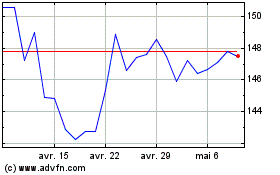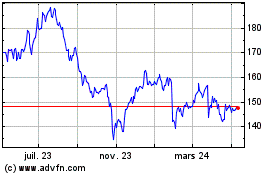Postal Service Is on Track to Gain Larger Share of Holiday Deliveries
23 Décembre 2015 - 2:24AM
Dow Jones News
By Laura Stevens
This holiday season, the letter carriers for the U.S. Postal
Service have been busier than an army of elves, operating
practically 24/7 to try to take a significant share of a
record-breaking online shopping season.
So far, USPS is on track to scale a new high in holiday
deliveries, as its volume is up more than 15% compared with a year
ago and is forecast to reach more than 600 million packages between
Black Friday and New Year's Eve.
Based on that number, the agency's market share of holiday
deliveries this year will increase to 40% from last year's 35%, as
it continues to elbow its way into an e-commerce market long
dominated by United Parcel Service Inc. and FedEx Corp.
"We're putting more pressure on the organization to grow the
business and to look at opportunities to continue to grow," said
Postmaster General Megan Brennan. "And I think given the pace of
innovation and what we've demonstrated in terms of our capability,
we're well positioned."
The Postal Service also has taken several steps to prepare for
this peak holiday season, including deploying additional
package-sorting equipment. Carriers and post offices are equipped
with more than 200,000 blue, package-scanning devices to improve
tracking data.
It has hired seasonal workers--about 30,000 this year--along
with its own employees to increase the number of delivery shifts in
some areas to three a day from one.
And it is running the equivalent of about 25,000 routes on
Sunday, up from 4,000 on a nonpeak Sunday. Both UPS and FedEx
typically don't deliver on Sundays.
"That ability to deliver on Sundays takes tremendous pressure
off the week," Ms. Brennan said. "That has certainly been a game
changer in our ability to keep the network fluid."
The Postal Service's ambitious holiday plans are just the latest
in a series of efforts to compete with UPS and FedEx in the battle
for online shipping. But the efforts have been costly since its
aging network was built for letters, not packages. Compensation
expenses increased 2.3% in fiscal 2015 to $35.9 billion, in part
due to growth in packages, the agency said.
In September, the USPS requested permission to raise prices on
its lightweight category, last-mile packages by 23.5%, because it
was only making about a penny per package on those deliveries.
Ms. Brennan acknowledged that it is a challenge to balance the
workload associated with packages with the costs. She said the
agency is working to manage overall expenses and expects to present
good numbers for the quarter.
"As a general rule, anytime the Post Office takes on more
business, especially during peak with all those extra costs, the
profitability goes way down," says Keith Byrd, a partner at
shipping consultancy Transportation Impact.
A typical mail truck can hold an average of about 70 packages,
compared with about 200 for a FedEx or UPS truck, according to
Satish Jindel, president of ShipMatrix Inc. Despite some scattered
reports of hiccups, so far its last-mile delivery service is coming
in at about 99% on-time, higher than the national networks of
rivals UPS and FedEx.
The Postal Service pays for its own way: it doesn't receive
taxpayer dollars to cover operating costs, although it is
compensated for certain services and receives a $15 billion credit
line with the U.S. Department of the Treasury. In November, the
agency reported a $5.1 billion loss for fiscal 2015. Stripping out
certain items including mandated retiree benefits, it would have
earned $1.2 billion.
The Postal Service in recent years has started competing more
aggressively for parcel business as its lucrative business--First
Class mail--has declined in the digital age.
It lowered prices last year on some of its Priority Mail
packages, and most recently has been testing out same-day
deliveries of groceries, water and fish.
It also has become a more attractive option for both lightweight
and bulky packages, after both UPS and FedEx started charging by
the size and weight of packages this year to encourage shippers to
use smaller boxes.
"I think the Postal Service is positioning itself for the
future," said Gordon Glazer, a shipping consultant with Shipware
LLC. "It's important to be seen as a viable carrier."
Write to Laura Stevens at laura.stevens@wsj.com
(END) Dow Jones Newswires
December 22, 2015 20:09 ET (01:09 GMT)
Copyright (c) 2015 Dow Jones & Company, Inc.
United Parcel Service (NYSE:UPS)
Graphique Historique de l'Action
De Juil 2024 à Août 2024

United Parcel Service (NYSE:UPS)
Graphique Historique de l'Action
De Août 2023 à Août 2024
